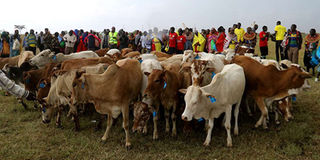How agency fosters peace in troubled Samburu, Pokot regions

Heifers are presented as gifts among the Samburu and Pokot youth during the Children Peace Initiative at Longewan Primary School, Samburu County, on August 20, 2015. The programme has helped lessen ethnic-related violence. PHOTO | FILE | NATION MEDIA GROUP
What you need to know:
- The programme by CPI-Kenya was designed to end perennial conflict between the Samburu and Pokot. And it has worked.
- Government agencies are supportive of the project, which they believe is the solution to persistent cattle raids and general insecurity in the North Rift region.
The day did not turn out to be an exciting one as Baraka Lolmodooni would have expected when his friend failed to turn up.
They were to jointly receive a heifer with Wilson Kokoyo. The two young men, who are to progress to Form Two in January, were in a group of 100-plus other youths from the Samburu and Pokot communities who had gathered to celebrate six years of friendship and signify the end of another year of peaceful co-existence between the two warring groups.
In their primary school days, the 17-year-olds would never fail to visit each other during school holidays, spending part of the vacation in either of the other’s home.
This is part of an initiative in which school children are used to promote peace between their warring communities.
CLUBS
They come together to build friendship while in school. Eventually, the peace networks are extended to their family members and other people in their respective communities.
“We learnt that children are honest with each other. They are sincere, not like adults who you cannot use to achieve peace,” Mr Hilary Halkano, Children Peace Initiative (CPI) Kenya CEO, pointed out.
He said they first formed peace clubs in primary schools in different parts of pastoralists’ communities in North Rift region and other parts of Northern Kenya.
It is through these clubs that Baraka and Wilson, who were studying at neighbouring primary schools, met. They would visit each other and share their problems through letters.
The boys have maintained their friendship after joining secondary school.
BONDING
CPI-Kenya had organised a ceremony at Plesian Primary School to mark the end of another year of friendship for 102 Samburu and Pokot families.
The occasion was at Amaiya location, which is on the border of Samburu and Baringo counties. Dubbed “Heifers for Peace”, the families had been grouped in twosomes with each of the 51 pairs receiving a heifer.
A heifer, according to Mr Halkano, is meant to strengthen the bond that has existed between the families.
“One family received the heifer on behalf of the other. They will look after the animal and once it gives birth to an offspring, it will be given to the other family. This is how they strengthen the bond as there’s already a shared responsibility,” he explained.
Baraka, a Samburu, is the one who was receiving the heifer on behalf of his colleague from the Pokot community. Unfortunately Wilson and his mother were absent. This left his colleague, who had been accompanied by his mother Ruth Lolmodooni, lonely and miserable.
FEES
The Kokoyos failed to make it to the ceremony because their son was forced to drop out of school for lack of fees.
After completing their primary school, Wilson joined local Amaiya Secondary School while Baraka got a vacancy at Lolmolok Mixed Secondary School.
“We are trying our best to see that Celina (Kokoyo’s mother) is able to raise enough money to send her son back to school,” a visibly worried Mrs Lolmodooni told Sunday Nation.
She said it would disappoint them if Wilson drops out of school. The boy would have no alternative other than joining others in herding livestock, which the two communities are trying to discourage after enjoying years of peace.
“It is through him that I came to know his mother and we became family friends. We want the friendship to continue,” she said and noted that, unlike before, she’s able to criss-cross Amaiya Valley to do her business without fear.
SUCCESS
Before, members of her Samburu community could not attempt to go near Amaiya Market at Tiaty, Baringo. This is Pokot territory.
Pokots could also not dare step into the territory of their neighbours for fear of attacks. And most of the fighters or warriors are the young men who start target practice in their teens.
The programme by CPI-Kenya was designed to end perennial conflict between the Samburu and Pokot. And it has worked.
The communities had for years been fighting each other over control of pasture and water along the Amaiya valley, which is an extension of the infamous Suguta valley triangle. The triangle extends to other parts of Samburu County and West Pokot.
VIOLENCE
Though a semi-arid area, Amaiya is surrounded by hilly ground. The place has enough pasture for most parts of the year. Both communities share the valley.
Government agencies, including the Baringo County government, are supportive of the project, which they believe is the solution to persistent cattle raids and general insecurity in the North Rift region.
The communities living in this part of the country are armed and constantly engage each other in gun battles. It is only now that their children can go to school following the peace programme.
“We are tired of cattle rustling incidents that have left our county behind,” Patrick Kitilt, the director of natural resources in Baringo County, said.
Stephen Wasike, the assistant county commissioner, was also present and assured CPI of the commitment the national government has in supporting the programme.





